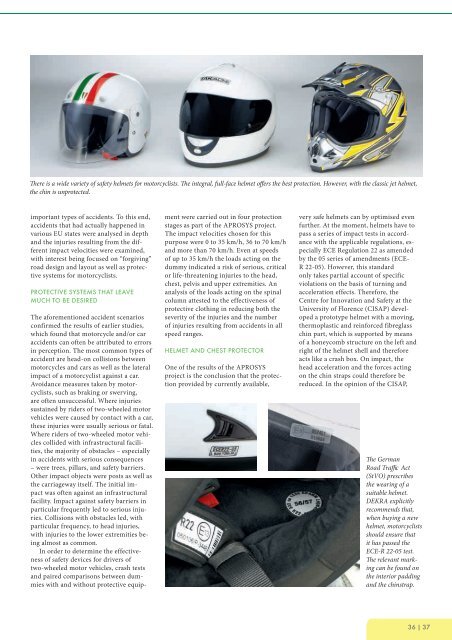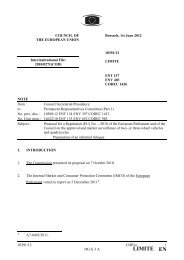MoToRcyclE RoAD SAFETy REpoRT 2010 - Dekra
MoToRcyclE RoAD SAFETy REpoRT 2010 - Dekra
MoToRcyclE RoAD SAFETy REpoRT 2010 - Dekra
Create successful ePaper yourself
Turn your PDF publications into a flip-book with our unique Google optimized e-Paper software.
There is a wide variety of safety helmets for motorcyclists. The integral, full-face helmet offers the best protection. However, with the classic jet helmet,the chin is unprotected.important types of accidents. To this end,accidents that had actually happened invarious EU states were analysed in depthand the injuries resulting from the differentimpact velocities were examined,with interest being focused on “forgiving”road design and layout as well as protectivesystems for motorcyclists.PROTECTIVE SYSTEMS THAT LEAVEMUCH TO BE DESIREDThe aforementioned accident scenariosconfirmed the results of earlier studies,which found that motorcycle and/or caraccidents can often be attributed to errorsin perception. The most common types ofaccident are head-on collisions betweenmotorcycles and cars as well as the lateralimpact of a motorcyclist against a car.Avoidance measures taken by motorcyclists,such as braking or swerving,are often unsuccessful. Where injuriessustained by riders of two-wheeled motorvehicles were caused by contact with a car,these injuries were usually serious or fatal.Where riders of two-wheeled motor vehiclescollided with infrastructural facilities,the majority of obstacles – especiallyin accidents with serious consequences– were trees, pillars, and safety barriers.Other impact objects were posts as well asthe carriageway itself. The initial impactwas often against an infrastructuralfacility. Impact against safety barriers inparticular frequently led to serious injuries.Collisions with obstacles led, withparticular frequency, to head injuries,with injuries to the lower extremities beingalmost as common.In order to determine the effectivenessof safety devices for drivers oftwo-wheeled motor vehicles, crash testsand paired comparisons between dummieswith and without protective equipmentwere carried out in four protectionstages as part of the APROSYS project.The impact velocities chosen for thispurpose were 0 to 35 km/h, 36 to 70 km/hand more than 70 km/h. Even at speedsof up to 35 km/h the loads acting on thedummy indicated a risk of serious, criticalor life-threatening injuries to the head,chest, pelvis and upper extremities. Ananalysis of the loads acting on the spinalcolumn attested to the effectiveness ofprotective clothing in reducing both theseverity of the injuries and the numberof injuries resulting from accidents in allspeed ranges.HELMET AND CHEST PROTECTOROne of the results of the APROSYSproject is the conclusion that the protectionprovided by currently available,very safe helmets can by optimised evenfurther. At the moment, helmets have topass a series of impact tests in accordancewith the applicable regulations, especiallyECE Regulation 22 as amendedby the 05 series of amendments (ECE-R 22-05). However, this standardonly takes partial account of specificviolations on the basis of turning andacceleration effects. Therefore, theCentre for Innovation and Safety at theUniversity of Florence (CISAP) developeda prototype helmet with a moving,thermoplastic and reinforced fibreglasschin part, which is supported by meansof a honeycomb structure on the left andright of the helmet shell and thereforeacts like a crash box. On impact, thehead acceleration and the forces actingon the chin straps could therefore bereduced. In the opinion of the CISAP,The GermanRoad Traffic Act(StVO) prescribesthe wearing of asuitable helmet.DEKRA explicitlyrecommends that,when buying a newhelmet, motorcyclistsshould ensure thatit has passed theECE-R 22-05 test.The relevant markingcan be found onthe interior paddingand the chinstrap.36 | 37




